Abhyanga Ayurvedic Massage: How To Do? Benefits, Oil Choices
Ayurveda explains massage as one among the daily routines that everyone has to follow. It explains that daily massage has the following benefits –
Table of Contents
Benefits of massage
Abhyanga means oil massage.
It should be done daily (Nitya).
Benefits of Abhyanga:
It delays Jara (aging),
Relieves Srama (tiredness),
Relieves excess of Vata (aches and pains).
Drishti Prasada – It improves vision,
Pushti – nourishes body tissues,
Ayu – prolongs lifespan,
Swapna – induces good sleep,
Sutvaktva – improves skin tone and complexion and
Dardyakrit – helps maintain a good physique.
Abhyanga should be done by everyone, everyday, especially old aged and tired people. It improves eye sight, nourishes muscles, improves age (life expectancy) and skin complexion.
Ayurvedic oil massage has good effect over all the body systems, rather than just a local effect on skin. For this very reason, in many diseases, especially having Vata imbalance, such as Arthritis, oil massage is highly recommended.
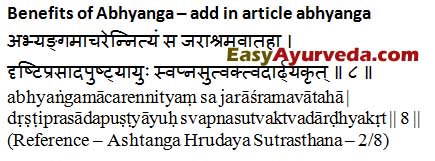
Mode of action
How does massage work?
Ayurveda explains that herbal oil contains oil and water soluble medicinal principles of the herbs. These medicines principles enter through the skin pores, become available for absorption at the end part of blood vessels, called Srotas and get absorbed into blood, reach the target area and exhibits its action. Cell membrane is made of lipoproteins (combination of lipids and proteins). Oils being a form of lipid, easily pass through the skin to the targeted area.
In cases of Ayurvedic massage, when oil is applied directly over the target areas such as knees, (in case of arthritis) absorption and therapeutic action is quick. This is the logic behind extensive use of massage as an effective Ayurvedic therapy in a number of diseases.
Allopathic pharmacology books explain that the medicines applied over the skin get absorbed unpredictably, haphazardly. Some of the doctors deny the massage benefits because they are of the opinion that the massage oil will not reach till the level of blood. There was a recent report about diclofenac (pain-killer) topical gel that application of this gel may cause even liver failure.
When an allopathic medicinal gel with diclofenac, rubbed over skin can get absorbed into blood stream and even cause side effects like liver failure, why not the active ingredients of the herbal oil get absorbed and bring about desired health benefits?
So, does massage really work? Yes! It does.
Right time for oil massage
Early morning, before bath is the traditionally indicated time.
If you have bodyache, which increases in working, then morning is the best time to apply, as the pain will be under control and you can get through the day quite comfortably.
If you divide the day into three parts, the last part – evening is dominated by Vata Dosha. Hence, oil massage / application can be done in the evening also. If massage is done in the evening, it is good to apply some hot fomentation after massage, this helps to avoid coldness and body stiffness. The warmth will improve better absorption and assimilation.
In relation to food:
Usually any type of massage is given 1 hour before or after taking food. When the food is taken and digestion sets in, Kapha will be dominant. Massage helps to balance Vata Dosha. Hence, it is not ideal to do massage when Kapha is dominant.
Massage for chronic pain
Utility of Ayurvedic massage therapies in managing chronic pain:
When there is a fresh muscle or tendon injury, the process of inflammation sets in. This is treated with anti inflammatory medications and the problems related to the injury – such as pain, swelling, etc are taken care of.
But in some patients, the muscle damage heals well in the initial stages but pain recurs after several years.
This recurring pain is due to following causes:
1. Muscles and tendons becoming weak due to ageing and tissue degeneration
2. Wrong body postures while sitting, sleeping etc, causing the twitching of muscles and tendons. This worsens the wear and tear of old injured muscles.
3. Tiny scar tissue formation in the muscles which make them stiff over a long period of time.
4. Provocative factors such as depression, junk foods, smoking, excess alcohol, aerated drinks, stress, anxiety and diabetes causing build up of free radicals. This leads to inflammation build up in the body, leading to resurfacing of pain.
5. An accident or repeated injury causing flaring up of old pains.
Ayurvedic oil massage can help to manage pain in above conditions.
Can everyone undergo Oil massage treatment?
Massage oil composition
Basis behind Ayurvedic massage oil composition:
If you observe composition of Ayurvedic massage oils, they will obviously have regular anti inflammatory herbs like
- Dashamoola (Group of 10 roots),
- Rasna – Pluchea lanceolata (Pluchea lanceolata),
- Devadaru – Cedrus deodara
- Prasarini – Paederia foetida
- Ela – Cardamom – Elettaria cardamomum
- Kushta – Saussurea lappa
But apart from the above, they also will have other herbs that are useful in
- rejuvenating,
- anti ageing,
- scar tissue relieving,
- stress relieving and
- anti oxidant activities.
These extra herbs are useful to
- heal minute scars of muscle tissue,
- regeneration of tendons,
- ligaments of joints,
- muscle tissue scars,
- accelerate the process of healing and inflammation.
Examples
A few examples of such herbs in Ayurvedic oils are –
Mahanarayana oil – a very famous herbal oil used in Ayurvedic treatment of arthritis, paralysis, muscular and joint pain etc. Contains rejuvenating and anti oxidant herbs like
Ashwagandha – Indian ginseng – Withania somnifera, Asparagus racemosus, Tribulus terrestris, turmeric
Kottamchukkadi oil – an Ayurvedic oil used in the treatment of Vata disorders causing neuro muscular pains, sciatica, spondylosis etc.
Contains rejuvenating and anti oxidant herbs like Moringa, ginger, tamarind leaves etc.
Mahamasha taila – powerful Ayurveda oil, widely used in many neurological conditions such as neuralgia, paralysis, etc
Contains rejuvenating and anti oxidant herbs like
Ashwagandha, black gram, tribulus etc.
Balaswagandhadi Tailam – An Ayurvedic oil, used in Ayurvedic treatment of fever, weakness of muscles, bones and joints etc.
Contains rejuvenating herbs like
Ashwagandha, Bala – Country mallow etc.
Heating of oil
Should the massage oil be heated before using?
During summer, heating of the massage oil is not required. But during winter, especially if you are using coconut oil based oils (Kera Tailam), then it is better to heat the oil. Very cold oil may cause stiffness in some people, due to an increase of Kapha Dosha.
Heating of the abhyanga oil is not recommended in high Pitta people.
Heating the oil can be done just for 1 – 2 minutes (to 50-60 degree Celsius).
Heating is better done on a water bath, as shown in the picture below. This avoids direct heat to the oil, which may lead to burning or charring of the oil.
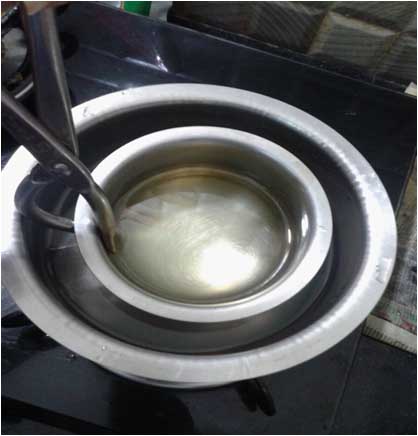
How to do massage?
On scalp – use your finger tips to reach to the scalp skin
On hair, use your palm.
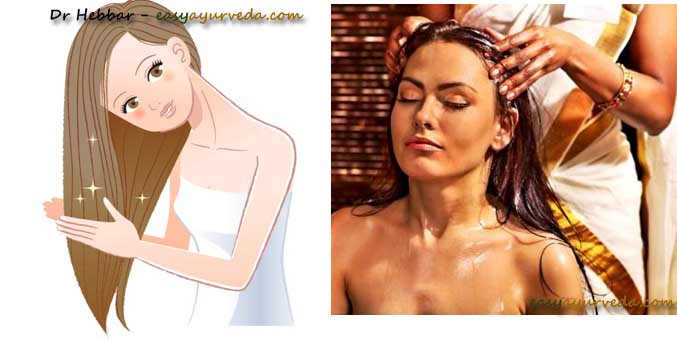
On forehead:
On forehead – use finger tips
Centre to sideways
Massage with medium pressure just above the eyebrows, from the centre towards the sides.
Read related: Ayurvedic Head Massage: Benefits, Procedure
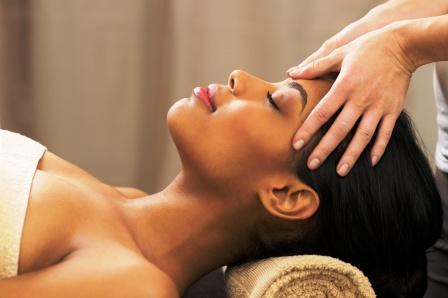
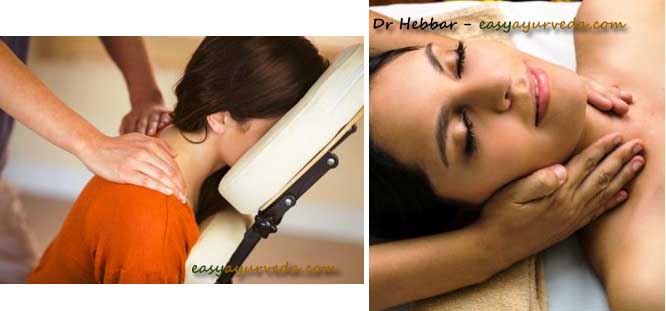
Face and ear: massage using the finger tips, in circular movements
On neck:
Use the root of fingers – between palm and fingers
Encircle the neck
Chest: Use the palm and fingers in a rotating motion on both sides
Abdomen:
Clockwise if you are doing it on someone else
Anti clockwise if you are doing it for yourself.
Zig zag from top to bottom
Back
From centre, outwards
Apply some pressure using the thumb
Apply firm pressure using the palms.
Buttock massage: Rotatory movement on both sides just like chest
Joints of hands and legs: Rotatory movements
Hands and legs:
From up, downwards, with the flow of muscles.
Use long strokes on the limbs (arms and legs) and circular strokes over the joints.
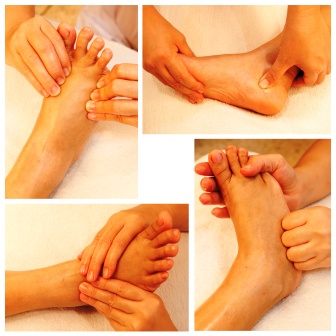
Foot massage: Use plenty of finger tips.
Read related: Foot massage: Ayurvedic Benefits, How To Do, Importance
Time for regular massage:
30 – 60 minutes( depends on the type of massage)
Massage is better when you get it done by someone.
Importance of Swedana
Importance of Swedana – sweating treatment:
Usually massage treatments are followed up with sweating treatment in the form of steam therapy, poultice. As per Ayurvedic principles, it helps in better absorption of the massaged oil and ensures quick healing.
Read related: How Steam Therapy After Oil Massage Is Beneficial?
No Time For Massage?
Go for weekend massage.
Ask someone in the house to give you a massage, at least once a week. Return the favour.
Do self massage, at least once a week
Go for Short Self Daily Massage technique (SSDM):
–Requires only 3 – 10 minutes
–Done by yourself, just before bath.
–Carries most of the benefits of a regular massage.
Read related: No Time For Massage? Here Is The Solution
Other massage therapies
Other than just oil massage, Ayurveda offers various therapies for better results.
Kati Basti and Greeva Basti therapies – Here hot Ayurvedic oils are pooled over lower back and neck respectively to treat respective problems.
Elakizhi therapy – Here we use the herbal drugs or leaves of medicinal plants obtained from nature for external treatments, to heal pains and related conditions and strengthen & rejuvenate joints, muscles and soft tissues.
Podikizhi therapy – In this, we use herbal powders heated or fried in herbal oils tied in a bolus to rub against the painful parts for a fixed duration of time so as to heal pains and related conditions, strengthen & rejuvenate joints, muscles and soft tissues.
Utility of Panchakarma
In some chronic disorders, the above said external therapies are not sufficient to bring down the pain and inflammation. In such cases, Ayurvedic Panchakarma therapies ensure removal of toxins from the body, improves blood circulation and nutrition supply to the affected regions and heals minute tissue injuries.
Rasayana therapies
Rasayana – rejuvenating, anti ageing therapies:
After Panchakarma therapies, Rasayana – rejuvenating, anti ageing treatment is administered. This is to ensure total rejuvenation and to reverse the degeneration of tissues. Here, Ayurvedic anti ageing remedies such as
Chyawanprash, Brahma Rasayana, Shilajit etc are administered for a period of a few weeks.
Two components of massage
Massage is used as a way of relaxation, healing with touch etc. Reflexology is healing with touch. So is the effect of massage in the oil we apply or the massage itself-means the touch, pressure, etc?
There are two components in Abhyanga – massage.
1. The effect herbal processed oil in bringing about its therapeutic effect, such as relieving pain, relaxing the muscle, inducing sleep, relieving anxiety, relaxing the mind and so on. These actions are brought about by the oil and its active herbal medicinal components.
2. The effect of touch / reflexology – The effect of touch healing therapy definitely helps in improving the benefits of the medicated oil used in massage. The touch, as everyone knows brings with itself a power of healing and reflexology / mild pressure exerted over the particular parts of the body and muscles helps to improve the muscle tone, circulation etc. Hence the effect of touch and the reflexology contributes to the effect of oil.
I would say that the massage oil is the main contributor to the healing because in several other therapies, oil is simply poured over the target organs, as in case of shirodhara, which is also beneficial. The touch / reflexology is a method or catalytic process to deliver the desired efficacy of the oil, in a more sophisticated way.
Massage for muscle knots?
Ayurvedic Massage Relieves All The Muscle Knots?
A few Ayurvedic massage parlors claim that Ayurvedic massage will relieve all the deep muscle knots in the body. This is a misleading claim.
It makes people with lipoma think that they can be cured just with an Ayurvedic massage, because lipoma mimics muscle knots. Ayurvedic massage, with massage oils and massage powders are really helpful in many ways. In many health conditions, massage is used in Ayurvedic treatment to –
- To relieve muscle pain,
- To relax muscles and mind
- To strengthen ligaments, joints and tendons.
- To improve skin quality and skin complexion.
But it does not relieve any muscle knots as such.
Time duration for oil massage
Article by Dr Raghuram Y.S. MD (Ay) & Dr Manasa, B.A.M.S
According to Dalhana commentary on Sushruta Samhita Chikitsasthana 24/30, time duration for Abhyanga has been mentioned. There is also a description about time duration required for penetration of Sneha at various levels of tissues.
Properly done Abhyanga is determined by the time required for medicinal principles of the oil to reach the deeper tissues of bones and marrows.
Sanskrit verse
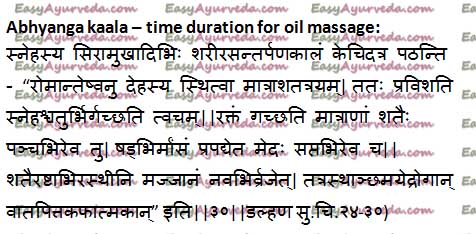
There are 7 dhatus or tissues according to Ayurveda –
- Rasa (lymph, nutrition essence or nutritive juice)
- Rakta (blood cells)
- Mamsa (muscle tissue)
- Meda (fat tissue)
- Asthi (bone)
- Majja (bone marrow)
- Shukra (semen, reproductive tissue)
Oil penetration time
According to Ayurvedic concept of tissue formation, the above said tissues are formed in the same chronology. Thus it will take least time for the medicinal effect of abhyanga to reach rasa dhatu and more time (maximum time) to reach majja dhatu.
Though Shukra or semen is the deepest tissue or the last tissue to be formed, Dalhana has not explained the reach of sneha to shukra dhatu when abhyanga is done. The explanation has been limited to the reach of sneha to majja dhatu.
In the below table, one Matrakala is the time taken to close and open the eyelids once.
| Body part / tissue | Penetrating time of oil |
| Hair follicle | 300 Matrakala (approximately 65 seconds) |
| Skin | 400 Matrakala (133 seconds) |
| Blood tissue | 500 Matrakala (160 seconds) |
| Muscle tissue | 600 Matrakala ( 190 seconds) |
| Fat tissue | 700 Matrakala ( 228 seconds) |
| Bone tissue | 800 Matrakala (240 seconds) |
| Bone marrow | 900 Matrakala (285 seconds) |
Time needed for herbal oil to reach the root of skin hairs – 65 seconds.
Time needed for oil / fat to reach skin = abode of rasa dhatu or represents rasa dhatu) – 133 seconds)=
Time needed for oil to reach bone marrow is 285 seconds. Therefore abhyanga should be done for 285 seconds for the medicines or medicinal effect of sneha to reach the bone marrow tissue.
Oil massage should be done in 7 different positions. In each position, abhyanga should be done for 2-5 minutes. Thus total time needed to complete full body massage is 15-35 minutes.
Time needed for doing Ekanga Abhyanga or local massage of head or single joint or portions of the body is approximately 15 minutes. (Ekanga Abhyanga should be done for at least 15 minutes).
The same time format shall be followed for Abhyanga done in both preventive (in healthy) and curative (in diseased) conditions.
The lower limit of time i.e. 15 minutes (2 minutes approximately in each position) shall be considered for abhyanga in healthy people and for of preventive purpose, even when done in dinacharya.
The higher limit of time i.e. 35 minutes (5 minutes approximately in each position) shall be considered for abhyanga in diseased conditions.
After Abhyanga, the person should be asked to rest for 10-15 minutes.
After rest, the sneha should be wiped using cloth dipped in hot water.
After swabbing, the patient should either be given swedana (sweating treatment) or snana (hot water shower) according to the plan and protocol of treatment (as planned).
Click to Consult Dr Raghuram Y.S. MD (Ayu) – Email / Skype
When to avoid Abhyanga?
वर्ज्योऽभ्यङ्गः कफग्रस्त कृतसंशुद्ध्यजीर्णिभिः ॥ ९ ॥
varjyo’bhyaṅgaḥ kaphagrasta kṛtasaṃśuddhyajīrṇibhiḥ || 9 ||
Ashtanga Hrudaya Sutrasthana 2nd chapter
Massage should be avoided when
There is increase of Kapha in the body,
Soon after Shodhana (Panchakarma procedure) and during Ajeerna (indigestion).
Why Oil Massage Should Not Be Done During Indigestion?
Daily Oil Massage – Balances down Vata Dosha but it can increase Kapha Dosha. Oil massage imparts oiliness to the body, it increases oiliness in the body. Oiliness is a Kapha quality. So, it also increases Kapha Dosha. In a Kapha disorder such as productive cough, the Kapha is already aggravated. Hence, it is best to avoid oil massage there, which itself could increase Kapha.
Soon after Panchakarma, the pores and channels are opened so that the toxins move out and also the digestion strength is low. So, doing massage then would cause blocking of channels, increases Kapha and decreases digestion strength.
Relationship between digestion strength and oil massage.
Oil -> Skin -> Bhrajaka Pitta of the skin -> It gets absorbed.
The oil or any medicine applied on the skin gets absorbed with the help of Bhrajaka Pitta (a type of Pitta in the skin).
If the digestion strength in the gut is low = Pachaka pitta low = Bhrajaka Pitta is also low = Lack of absorption of applied = Blockage of sweat and other skin related channels in the body, excessive unctuousness on the skin.
The ability of skin to absorb oil or medicine applied, depends on the digestion strength.
Time duration for oils to reach muscles
How much time does herbal oil take to act on muscles?
Answer by Dr JV Hebbar:
There are many Ayurvedic herbal oils targeted for muscle.
For example,
Murivenna, Mahanarayana taila and Dhanwantaram tailam to relieve muscle pain.
Bala Ashwagandhadi taila to improve the bulk and strength of the muscles. It is used for massages for gym going people. If you are going to gym, consider applying this oil, before or after workout.
Nirgundi taila – prepared with vitex negundo to relax the tensed up muscles and to relieve pain
Masha taila and Mahamasha taila – Used for improving muscle bulk, strength, to relieve muscle wasting. It is used for massage when there is muscle wasting after paralysis, after long term fracture bandage, etc.
Sahacharadi taila, Kottamchukkadi taila – to relieve muscle stiffness and lack of muscle flexibility, also to improve blood circulation to muscle. The use case is, after a muscle injury with a blunt instrument, muscle pull, joint stiffness associated with muscle pain as in rheumatoid arthritis etc.
Bala Taila, Maha Bala taila – to improve nerve conduction in muscle, to make the muscles more agile and responsive, after paralysis, palsy etc.
The time required for these oils to act on the muscles varies from person to person.
In younger people, the oils act quickly.
In a muscle injury of recent onset, the pain relief effect with oil application can be expected within just 2 days, though the complete pain relief may take 1 – 3 weeks.
Muscle pain relief takes just 1-10 days.
A paralyzed muscle may take 2 – 12 weeks to respond.
A wasted muscle may take 4 – 8 weeks to respond.
These are rough estimates.
The effectiveness of the oil also depends on the type of therapy adopted.
For example, if oil massage is followed up with sudation (sweating treatment), then the oil penetration will be deep into the tissues.
If oil is used in the form of
Dhara – streaming over the muscles,
Avagaha – dipping of the affected organ in the oil
Lepa – herbal paste with pain relieving herbs such as castor root, leaves, Nirgundi, Rasna, mixed with above-mentioned pain-relieving oils
Parisheka – sprinkling of oil over the limb / organ
Phizhicchil – wherein warm oil is steamed over the limb followed up with massage
These therapies enable longer exposure of the muscles to the oils, hence quicker will be its action.
The action of these oils on the muscles can be hampered if there is Ama – product of altered digestion and metabolism. Under such circumstances, kindling the digestive fire with spicy oral medicines such as Hingvashtaka churna gets rid of ama first. Then if oil massage is done, the oil absorption and action will be faster.
The action of these oils on the muscle can be fortified by taking oral medicines that further help to relieve inflammation, improve blood circulation etc. For example, pain relieving oil massage along with Sallaki tablet – Boswellia serrata – oral intake, will help to reduce the pain quickly.
Read related:
Muscle cramps: Causes, Symptoms, Ayurvedic Treatment, Herbs
Massage Oil Quantity
By Dr JV Hebbar
How much oil should we use for Abhyanga (oil massage)?
It depends on a few factors.
For an adult, anywhere between 30 ml to 50 ml is quite sufficient.
If you belong to Kapha body type or if you have oily skin, then a lesser quantity of oil is usually recommended because the body has sufficient quantity of oiliness within it and extra oil applied can block skin pores.
If you have an oily face but the rest of the body is not oily, then you may consider applying less oil on your face and wash it off within 5-10 minutes after application.
For example, Kumkumadi taila – just 2 – 5 drops on the face, gently rub with circular motion and wash off quickly.
If you have vata or Pitta body type, then you can use a slightly higher quantity of oil, say, 40 ml.
If you have aches and pains all over the body, then a higher quantity of oil is justified.
If you have aches and pains only in certain body parts, then in those painful areas, you can use more oil for massage, compared to the rest of the body parts. You may also dip a cotton swab or a piece of cotton cloth in the oil and place over the painful areas. This makes more quantity of oil to get absorbed into the muscles and bones, thereby relieving the pain.
For example, Mahanarayana oil over painful joints.
If you are applying a liniment, then the quantity of oil is just 5 – 15 drops. The liniments contain camphor, eucalyptus oil, menthol etc, that are useful to relieve pain but in excess, they may cause burning sensation. For example, Arthorub liniment
There are some types of aches and pains, where the oil should not be applied. Example, in cases of early stage of rheumatoid arthritis with extreme stiffness, heaviness and indigestion (Ama condition). You doctor will be the best judge to decide on the quantity and choice of oil.
Abhyanga can increase pain?
I underwent an Abhyanga massage in an Ayurveda center recently but after that my pain increased. What could be the reasons?
Dr JV Hebbar:
Oil massage has many contraindications. In many instances, where the patient has indigestion, soon after fever, in high Kapha conditions such as cough with sputum, obesity etc., Abhyanga is not recommended.
Another cause for increase of pain could be, lack of sufficient sweating treatment after Abhyanga. Sweating helps to absorb the applied oil better and also relieves stiffness of the body.
Some people take cold water showers after abhyanga, which can increase stiffness and cause an increase of pain.
In case of extreme joint and muscle stiffness, Abhyanga is not needed. There, another procedure called dry sweating therapy (Rookshana Sweda) in the form of Valuka Sweda is needed.








19 comments on “Abhyanga Ayurvedic Massage: How To Do? Benefits, Oil Choices”
vin
Sir, how many hours does it take for the oil to be completely accepted by the skin? I’m sure it is more than 45 mins as many claim.
Is it advisable for a healthy person to do full body oil massage before going to sleep or is it not advisable?
By this i mean overnight oil massage and just plain water bath in the morning.
Dr J V Hebbar MD(Ayu)
Many thanks for this thought-provoking question. I have answered in the form of an article. Please read it here – https://www.easyayurveda.com/2012/05/12/can-the-oil-be-left-overnight-what-is-absorption-time/
Gaurav
Is the “Marma” system part of (Charak Samhita’s) Ayurveda? Are there supposed to be well defined ‘marma points’ on the body i.e. skin which are somehow connected more directly to various internal organs, such that applying anything to those points might have even quicker/stronger effects on those organs, both good or bad…?
Dr J V Hebbar MD(Ayu)
We will be learning about Marma in near future.
RAJESH RAJAN
Hi doctor ..,
I am Rajesh rajan ,my question; is that any important to take steam after the Abhyanga and how its work on body ?
If any problem to give steam after the sirodhara and how its work?
i hope you will replay
Thank you
RAJESH RAJAN
Dr J V Hebbar MD(Ayu)
Hi, in reply to your query, I have made a video and wrote an article. Please read here – https://www.easyayurveda.com/2014/09/11/steam-therapy-oil-massage-beneficial/
Dr. veena
Dear sir
Indeed this is really good explanation.
Congrates for th 1000article.
Keep writing.
Regards
Dr. Veena
Dr Megharaj Paradkar, BAMS, MA (Sanskrit)
Your work is really appreciable doctor ! Thank you very much for continuous writing on Ayurveda. I have a question that I asked many practitioners, but could not get satisfactory answer. Hope you will answer the same. The question is – Is there any reference in Ancient Ayurvedic Sanskrit texts mentioning the direction of abhyanga and reasons for the same ? I searched Charak, Sushrut, Vagbhat but could not find the reference. Can you please provide the same ?
shubhamsheikhar
Dear Dr Hebbar,
Which oil should be used for massage for person having Kapha-Pitta doshas.
Thanks
Dr J V Hebbar MD(Ayu)
1. Nalpamaradi coconut oil
2. Room temperature only.
chinmaya
1) What are various types of massage techniques? (as various types of massages are now available in market: ayurvedic, marma, kalari, lymphatic, balinese, shiatsu, deep tissue etc etc. )
2) When to choose which massage? Are all have same effect ?
Dr J V Hebbar MD(Ayu)
Few massages as per Ayurveda are explained here
https://www.easyayurveda.com/therapies/
Rangaswami
Another excellent article easily understandable by common man. I for one has been using Mahanarayana Thailam with Karpooradi Thailam in equal proportion with good result. Thank you doctor.
Chaitali
Is hemp seed oil cooling or heating?
Dr J V Hebbar MD(Ayu)
Heating.
Anu
Which oil is good for abhyngam if concentrating for weight loss.
Dr J V Hebbar MD(Ayu)
Sesame oil, Saindhavadi taila
Dr. Rajashri Sonti
sir is Vasa (Muscle fat) or Majja (Marrow) used as Sneha for Abhyanga anywhere today as mentioned in classics
Dr J V Hebbar MD(Ayu)
It is very frequently used in abhyanga, basti (enema treatment etc) in many Ayurveda institutes, especially government Ayurveda college hospitals of Karnataka.